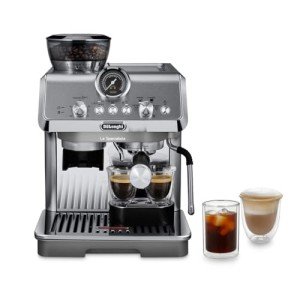The Rise of Home Espresso Machines: A Comprehensive Guide
As coffee enthusiasts continue to seek fresh and delicious brews at home, the popularity of home espresso machines has actually risen in current years. No longer just the domain of coffee shops and coffee bar, these machines empower people to craft barista-quality espresso drinks from the convenience of their kitchens. This short article will explore the different types of home espresso machines, their functions, and considerations for selecting the best one. Additionally, Dual Boiler Espresso Machines will provide a selection of FAQs to assist prospective buyers make notified decisions.
Kinds Of Home Espresso Machines
Home espresso machines can be categorized into a number of categories based upon their mechanisms and user-friendliness. Each type has its distinct features, pros, and cons.
| Type | Description | Pros | Cons |
|---|---|---|---|
| Manual Espresso Machines | Requires the user to manually manage the developing procedure, involving methods like pulling a lever to produce pressure. | - Complete control over developing procedure - Compact design | - Requires skill and practice - Time-consuming |
| Semi-Automatic Machines | Machine automates water circulation and pressure, however the user still controls the dosing and duration of the brewing process. | - Balance of automation and control - Versatile | - Learning curve for refining techniques |
| Totally Automatic Machines | Automates the entire developing procedure, from grinding to brewing, often with programmable settings for tailored beverages. | - Extremely user-friendly - Quick and convenient | - Less control over the developing process - Higher cost point |
| Capsule or Pod Machines | Uses pre-packaged espresso pills or pods to create coffee rapidly and easily. | - Extremely easy to use - Minimal cleanup | - Limited taste range - More costly per cup than ground coffee |
| Super-Automatic Machines | Combines features of completely automatic machines with integrated mills, enabling users to brew entire bean espresso and milk-based drinks with one touch. | - All-in-one benefit - Ideal for milk-based drinks | - Often the most costly - Can be large |
Features to Consider
When choosing a home espresso machine, potential buyers need to think about the following functions to guarantee they pick a machine that satisfies their requirements:
Grinder Type:
- Built-in mills can supply fresher premises but may need more upkeep.
- Separate mills permit more customization of grind size.
Pressure:
- Look for machines that produce a minimum of 9 bars of pressure, which is optimum for brewing espresso.
Water Temperature Control:
- Machines with adjustable temperature level settings permit much better extraction of taste from beans.
Milk Frothing Options:
- Consider whether you desire a manual steam wand for frothing or an automatic milk frother for benefit.
Alleviate of Cleaning:
- Machines with removable parts and self-cleaning functions significantly decrease clean-up time.
Size and Design:
- Ensure the machine fits comfortably in your kitchen and aligns with your aesthetic preferences.
Budget:
- Set a budget before starting your search, as costs can range significantly from affordable models to high-end machines.
Benefits of Home Espresso Machines
Owning a home espresso machine provides various advantages:
- Cost-Effective: Over time, brewing espresso in the house can save coffee lovers cash compared to frequent café sees.
- Customization: Users can try out various beans, grind sizes, and developing methods to discover their ideal cup.
- Convenience: The ability to brew espresso whenever eliminates the requirement to head out to a coffee shop, particularly beneficial throughout late nights or mornings.
- Quality Control: With a home machine, people have complete control over the quality of components and developing processes.
Disadvantages of Home Espresso Machines
Nevertheless, there are some downsides to think about:
- Initial Investment: High-quality espresso machines can be pricey, needing a considerable upfront financial investment.
- Knowing Curve: Mastering the art of espresso developing can take time and practice, which might be intimidating for newbies.
- Upkeep: Like any appliance, espresso machines need routine cleansing and upkeep to guarantee optimal performance.
FAQs
1. What is the best kind of home espresso machine for newbies?
Response: For beginners, a semi-automatic machine is frequently recommended as it provides a balance between control and automation, enabling you to learn the essentials without frustrating intricacy.
2. Just how much should I invest on a home espresso machine?
Answer: Entry-level machines can start around ₤ 100 to ₤ 300, while higher-end models can range from ₤ 500 to over ₤ 2000. It's vital to set a budget based on your expected use and desired features.
3. Do I require a separate grinder?
Response: While some espresso machines include built-in grinders, purchasing a separate grinder enables greater modification and guarantees much better quality premises.
4. How frequently should I clean my espresso machine?
Answer: Cleaning frequency can vary by machine type, however it's generally suggested to clean up the machine after each use and perform deep cleansings weekly or regular monthly, depending upon use.
5. Can I make milk-based beverages with any espresso machine?
Answer: Not all machines come with milk frothing capabilities. If you enjoy drinks like lattes or cappuccinos, look for a machine with a steam wand or automatic frother.
Home espresso machines are changing the way coffee enthusiasts enjoy their precious brews. With various types and advanced functions available in the market, there is something for everyone. Whether it's the joy of creating distinct dishes or merely enjoying the best shot of espresso, buying a home espresso machine can enhance both the coffee-drinking experience and the lifestyle for coffee lovers all over. Just like any investment, it is crucial to weigh the benefits versus the possible downsides and choose a machine that effortlessly fits both your way of life and choices.

